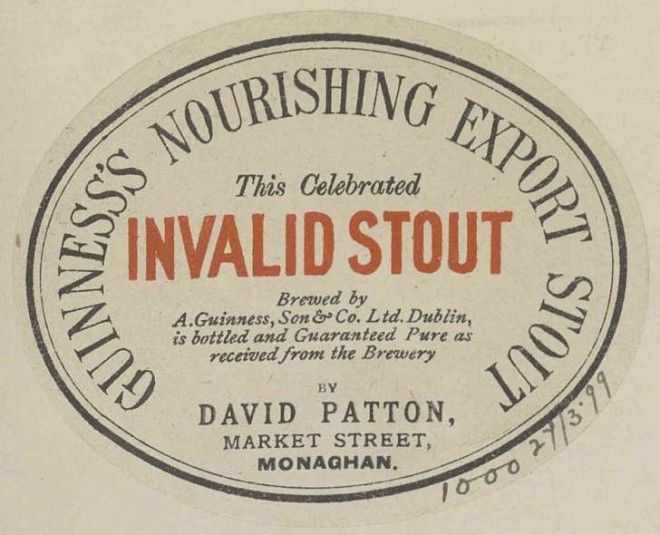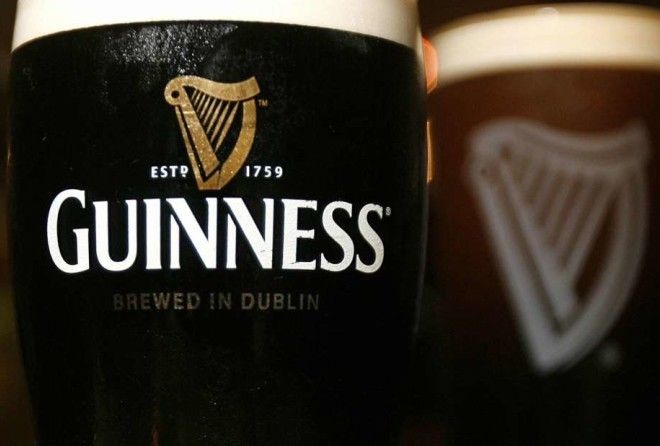With so much history, it's no surprise that the Guinness Storehouse Archives—which are open to the public—are stuffed with intriguing artifacts that tell some pretty wild stories. Here are a few.
1. THE LEASE TO THE DUBLIN BREWERY WAS INTENDED TO LAST 9000 YEARS.
In 1759, founder Arthur Guinness signed a lease for a four-acre property at St. James’s Gate in Dublin. The lease required a down payment of £100, an annual rent of £45, and a term of 9000 years (not a typo). Such lengthy leases were relatively common back then: “At the time in Ireland, there was a lot of instability to do with land tenure,” explains Fergus Brady, Archives Manager at Guinness. Centuries earlier, the British had begun confiscating land from native Irish in an effort to build plantations, and extra-long leases were a means of avoiding this fate. As Brady explains, “You see these really long leases: 99-year or 999-year leases. It seemed to be a legal custom at the time that they used the number nine.”
2. ARTHUR GUINNESS WAS NOT AFRAID TO DEFEND HIS PROPERTY WITH A PICKAXE.
In 1775, the Dublin Corporation—that is, the city government—demanded that Arthur Guinness pay for the spring water flowing to his brewery. When Guinness argued that he was already paying for water rights through his 9000-year rental agreement, the Dublin Corporation sent a sheriff and a committee to his brewery to cut off the water supply. Guinness was livid. He seized a pickaxe and unleashed a torrent of obscenities so colorful that the Dublin Corporation’s goons eventually retreated.
3. GUINNESS ONCE DEPLOYED FIELD AGENTS TO CATCH COUNTERFEITERS.

In the 19th century, there was no such thing as brand consistency. Guinness did not bottle its own beer; instead, it shipped the suds in wooden casks to publicans who supplied their own bottles and applied their own personalized labels. Occasionally, these publicans sold fake or adulterated Guinness. To prevent such sales, the company sent special agents called “travellers” into the field to collect beer samples, which it tested in a laboratory. “If a publican was found to be serving adulterated or counterfeit Guinness, they had to give a public apology in their local newspaper—and even the national newspapers,” archivist Jessica Handy says.
4. FOR 21 YEARS, THE COMPANY HIRED A GUY TO TRAVEL THE WORLD AND DRINK BEER.
In 1899, Guinness hired an American ex-brewer named Arthur T. Shand to be a “Guinness World Traveller.” It was arguably the coolest job in the world. For 21 years, Shand traveled the world taste-testing beer. According to Brady, “His job was to travel the world and taste Guinness, say whether it was good or bad, who our bottlers in the market were, who our major competition was, what kind of people were drinking our product.” Shand traveled to Australia and New Zealand, to Southeast Asia and Egypt. “He was sort of a Guinness sommelier,” Brady says.
5. THE COMPANY'S HARP LOGO CAUSED TROUBLE WITH THE IRISH GOVERNMENT.
The Celtic harp—based on the 14th century “Brian Boru Harp” preserved at Trinity College—became a trademarked Guinness logo in 1876. Forty-five years later, when Ireland gained independence from England, the Irish Free State decided to use the same Celtic harp as its official state emblem. This became awkward. Guinness owned the trademark, and the Irish government was forced to search for a workaround. You can find their solution on an Irish Euro coin. Look at the coin, and you’ll notice that the harp’s straight edge faces the right; meanwhile, the harp on a glass of Guinness shows the straight edge facing left.
6. GUINNESS REPORTEDLY SAVED LIVES ON THE BATTLEFIELD.
The old slogan “Guinness is good for you” sounds like a marketing gimmick, but it was born out of a genuine belief that the beer was, in fact, a restorative tonic. The health claim dates back to 1815, when an ailing cavalry officer wounded at the Battle of Waterloo reportedly credited Guinness for his recovery. For decades, the medical community widely claimed that the dark beer possessed real health benefits—and they weren’t necessarily wrong. “There was little safe drinking water at the time,” Handy says. “But with brewing, consumers knew they were getting a safe beverage.”
7. THE COMPANY CREATED A SPECIAL RECIPE FOR CONVALESCENTS.

From the 1880s to the 1920s, Guinness produced a special “Nourishing Export Stout”—a.k.a. “Invalid Stout”—that contained extra sugars, alcohol, and solids and came in cute one-third pint bottles. “It was very common practice for people to buy a couple bottles and keep them as a tonic, even if it was just a glass or half a glass,” Handy says. In fact, Guinness went as far as asking general practitioners for testimonials attesting to the beer’s medical benefits. According to Brady, “Many of them wrote back and said yes, we prescribe this for various ailments.” One doctor even claimed a pint was “as nourishing as a glass of milk.”
8. DOCTORS REGULARLY PRESCRIBED THE BEER TO NURSING MOTHERS.
From the 1880s to the 1930s, many physicians believed Guinness was an effective galactagogue—that is, a lactation aid. The company sent bottles to hospitals as well as wax cartons of yeast (which supposedly helped skin problems and migraines). Hundreds, possibly thousands, of doctors prescribed the beer for ailments such as influenza, insomnia, and anxiety, David Hughes writes in A Bottle of Guinness Please: The Colourful History of Guinness. According to Brady, the company was sending beer to hospitals as late as the 1970s.
9. THE COMPANY ONCE DROPPED 200,000 MESSAGES-IN-A-BOTTLE INTO THE OCEAN. Advertising

In 1954, Guinness dumped 50,000 messages-in-a-bottle in the Atlantic, Pacific, and Indian Oceans. In 1959, they repeated the stunt again, with 38 ships dropping 150,000 bottles in the Atlantic. The first bottle was discovered in the Azores off Portugal just three months after the initial drop. Since then, the bottles have turned up in California, New Zealand, and South Africa. Just last year, a bottle was discovered in Nova Scotia. (If you find one, you just might be offered a trip to the Guinness Storehouse in Dublin.)
10. THE PERSONNEL FILES IN THE GUINNESS ARCHIVES CONTAIN SOME DOOZIES.
The Guinness corporate archives are open to the public. According to Handy, “Some of the stories you get in there are amazing, because you get accident reports and you get crazy stories of people bouncing on bags of hops outside the brewery." This may sound less surprising considering that, back in the day, Guinness employees were given an allowance of two pints of beer every day.
11. A GUINNESS SCIENTIST MADE A STATISTICALLY SIGNIFICANT MARK IN THE FIELD OF STATISTICS.
If you’ve taken a statistics class, you might be familiar with the Student’s t-test or the t-statistic. (It’s a method of working with a small sample size when the standard deviation is unknown.) The t-test was first described by William S. Gosset, a brewer and statistician at Guinness who was attempting to analyze a small sample of malt extract. Gosset’s discovery not only helped Guinness create a more consistent-tasting beer, it would lay the bedrock for one of the most important concepts in statistics: statistical significance.
12. GUINNESS IS SO BIG IN AFRICA, IT LAUNCHED A SUCCESSFUL FEATURE-LENGTH FILM.
Guinness began exporting beer to Africa in 1827. In the 1960s, it opened a brewery in Nigeria—followed by Cameroon and Ghana. Today, there are reportedly more Guinness drinkers in Nigeria than there are in Ireland. “In Ireland, England, and the United States, everybody thinks that Guinness is synonymous with Ireland,” Brady says. “But in Nigeria, there’s a very very low conception of that.” The beer is such a cultural staple that a fictional character who advertised the product named Michael Power—a James Bond-like, crime-fighting journalist—became the star of a feature film in 2003 called Critical Assignment, which was a box office smash. (Of course, there’s some branding built into the script. As Brady explains, “There are definitely scenes where Michael Power is enjoying a pint of Guinness.”)
13. DISPENSING BEER WITH NITROGEN WAS ORIGINALLY CONSIDERED LAUGHABLE.
In the 1950s, Guinness scientist Michael Ash was tasked with solving the “draft problem.” At the time, dispensing a draft pint of Guinness was ridiculously complicated, and the company was losing market share to draft lagers in Britain that could be easily dispensed with CO2. “The stout was too lively to be dispensed with CO2 only,” Brady says. “Ash worked on the problem for four years, working long hours day or night, and became a bit of a recluse apparently. A lot of doubters at the brewery called the project ‘daft Guinness.’” But then Ash attempted dispensing the beer with plain air. It worked. The secret ingredient, Ash discovered, was nitrogen. The air we breathe is 78 percent nitrogen. Today, a Guinness draft contains 75 percent nitrogen. Not only did the discovery make dispensing the beer easier, it created a creamy mouthfeel that’s been the signature of Irish stouts since.
Full disclosure: Guinness paid for the author to attend an International Stout Day festival in 2017, which provided the opportunity to speak to their archivists.

